 One of the ultimate excuses for not measuring impact of Marketing campaigns is: "Oh, that's just a branding campaign."
One of the ultimate excuses for not measuring impact of Marketing campaigns is: "Oh, that's just a branding campaign."
Admit it, you've heard it.
I suspect you've even used it liberally!! : )
Before we go any further I must clarify that I love branding campaigns just as much as the next guy.
I love campaigns that Visa runs. I love watching the IBM ads (with the Linux kid perhaps the best of the lot). I loved the I'm a PC ads from Microsoft (and I am a proud PC!). I loved the Wario Land: Shake It ad from Nintendo on YouTube (now that's creative!). I love a good billboard ad, Budweiser does good ones. My absolute favorite branding campaign of all time: Think Different.
I could keep going on.
The common theme through the above campaigns is that their primary purpose is "branding". The hope is by connecting with you, or interrupting you, a lasting impressing, a feeling, might be left in you so when its time to get a credit card you think of Visa and not MasterCard, when it comes time for hiring consultants for a multi year project you'll choose IBM and so on and so forth.
All well and good.
Here is the minor problem.
There is a very tenuous connection between these campaigns and outcomes, they are for the most part faith based initiatives. If supported by "data" then it tends to be of the most fragile kind (usually the fact that the CEO saw it during the Super Bowl and felt happy suffices as actionable data).
None the less they persist.
Online it does not have to be that way.
It is criminal not to measure your direct response campaigns online. I think we have established that. I also believe that a massively under appreciated opportunity exists to truly measure impact of branding campaigns online. Paid Search or affiliates or email or display or YouTube or whatever channel you end up choosing.
[Oh and don't tell me that your "branding" campaign is to increase "engagement"! Remember: Engagement is not a metric, its an excuse.]
The Top Secret Hidden Never To Be Reveled Come Hell Or High Water Key To Measuring Branding Campaigns:
Answer this simple question: Why %&#$!^ are you doing the "branding campaign"?
Every campaign, and in turn website has a purpose. All you need to do is figure out what the purpose of your campaign is, no matter how outlandish (or childish) your goal.
The typical focus by companies, and the creative types in their employ, is to simply focus on figuring out what you are doing to do in the campaign.
I am recommending that they hold their horses / put their pants back on / slowly sit down in their over-stuffed chairs. You too!
Figuring our what you are going do do with your campaigns can come after you figure out why you are doing these campaigns. No, not just because you have money or because that is how things have always been and absolutely not because someone (a HiPPO!) asked you to.
Once you know the desired outcome you'll be surprised to learn all the wonderful measurement possibilities that await you online, things that would be nearly impossible offline. [The web rocks!]
Measurement Recommendations for Desired Branding Outcomes.
In order to help you make the leap in the rest of this post I want to share the most common outcomes I have heard associated with branding campaigns, and my recommendations as to what they should measure for their brand campaigns online.
My hope is that this bushel of ideas will spark your own creativity when it comes to measuring your campaigns.
Outcome #1: To attract "prospects" / new customers.
This is perhaps the most common desired outcome: "I am doing branding campaigns to attract new prospects to our website. They will come, they will be wowed by our glory, they will immediately convert."
It is not very hard to measure these campaigns.
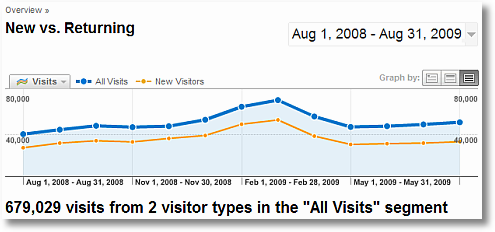
Measure the change in the percentage of New Visitors to your website, its the orange line in the graph above.
Ideally you'll measure the number prior to your branding campaign, say Feb 2009, and then you'll measure it again during your campaign, March 2009. See if you were able to get more traffic to arrive at your site, and if they were Existing Visitors or New Visitors (hopefully measured with a first party cookie in your website analytics tool).
For good measure, just to be extra sure you'll segment out the visitors who come by clicking on your campaigns (display/banner, YouTube, rich media, whatever), and see how many of them were truly new.
At this point there is no expectation that any other outcome was delivered, just a visit by someone who had never been to your site before. A fairly low bar.
Outcome #2: To share your business value proposition.
You are a news site like The New York Times or you are a non-profit like Idealist or you are the team running Google Maps.
The goal of your campaigns is to simple share your unique value proposition with everyone. They'll be impressed enough to come visit your site and then do so repeatedly.
The ideal metrics for this desired outcome are Visitor Loyalty & Visitor Recency.
(Click on image for a higher resolution version.)
The data in the above report shows how frequently during a time period do the website's visitors visit the website. In the Before version you can see that most people, 69.79%, visited the website just once. In the After version, when the branding campaigns were running, only 63.25% of the visitors visited just once. Which means atleast 7% of the visitors shifted to visiting more than once.
You can credit the branding campaigns with that shift (if that is all you were doing). Better still you can segment the traffic from the campaigns and validate that hypothesis.
If people were impressed enough with your value proposition and visited more often the brand campaign was a success.
Another good idea is to measure segmented Visitor Recency.

In this case the analysis will try to judge if the traffic acquired by paid search branding campaigns is visiting my website more frequently in any time period, when compared with other segments of traffic (in this case I am comparing it to All Visits).
Outcome #3: To impress people about your greatness and buy more.
I wanted to put this as #3 because if it were a "conversion" campaign then it would not be a "branding" / feel good campaign.
But there are certainly campaigns that you run to prop up your brand that will entice people to buy more from you. If they were only going to buy underwear then now they'll also buy a pair of shoes and headphones.
I recommend segmenting the traffic and measuring revenue lift but also measuring the average order size, if you did your job right then that latter number should be higher.

In this case our Yahoo! display campaigns did wonderfully in terms of conversion rate, but not in terms of the major goal of the campaign – sell more stuff.
Another thing people forget is to measure the overall impact, beyond simple conversions. Sure measure it as above but it is also good to marry up the qualitative data and measure Task Completion Rate using a onexit survey tool (use a free one like 4q from iPerceptions).
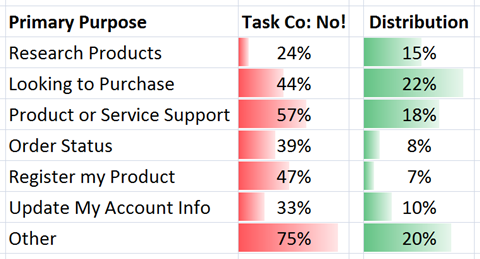
You can accomplish these goals:
~ Get an optimal understanding of what kind of people you ended up attracting to your website (look at primary purpose & distribution).
~ Were these people, even if all you wanted from them was to buy from you, able to complete their tasks.
In the above case that is clearly not true.
Perhaps your Average Order Size is not great because only 44% of the people who came to buy, as a result of your branding campaigns, were able to complete their task!
You would have fired your ad agency for a crappy campaign, turns out they did their job well but it was your website that stunk. Perhaps someone in your team needs to get fired? Perhaps you? (Just teasing!)
Note how marrying the Qualitative and Quantitative data can be helpful and identify true points of failure / success.
Outcome #4: To whisper sweet nothings to drive offline action!
Most commerce / love / stuff still happens in the real world and many many companies use various online marketing channels to drive people to take offline action (make purchases in stores or via their phone channel, show up for a woman's rights rally, meetup at a concert etc).
You can measure the impact of these campaigns right on your website, using any onexit survey tool and by applying some delightful regressions on your data. You can compute two important metrics:
Likelihood to Recommend / Brand Lift
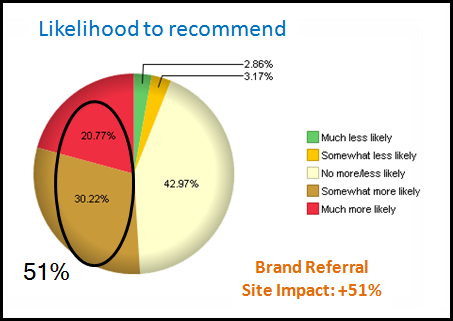
You can measure this at an aggregate level, or you can measure it just for your campaign traffic.
It helps you understand what was the brand lift, positive, as a result of the person's complete experience (your campaign, plus your website).
Likelihood to make a Offline Purchase / Action

Simple right? Well it takes some planning but it is not that hard to measure (and if you get a decent sample size then you can also segment this data easily by source of traffic, brand campaigns, and show a causal relationship).
Phone Calls / Conversions Driven from Website
Another wonderful way to track offline impact of your campaigns is to use unique phone numbers with your campaigns (either on your display banner ads or on your website).
You can track the number of phone calls made to your call center, by campaign (or keyword or whatever) and if you have a integrated IVR then you can also track conversions / sign ups from those campaigns.
Companies like Fresh Egg in the UK or Mongoose Metrics and Ifbyphone in the US, amongst many others, provide these phone call tracking solutions.
[Bonus reading material: Multichannel Analytics: Tracking Offline Conversions. 7 Best Practices]
Outcome #5: To break through the noise / make an introduction to your business.
Very often when you run branding campaigns your goal is simply to introduce your business (like we are trying to do with Market Motive, our start up that provides certification courses in Web Analytics, SEO, PPC, PR etc etc).
A common mistake in this case is to simply focus on one outcome. If you are running a branding campaign then it is likely that you either have a very soft call to action or, more likely, you have a very general "our business is magnificent" message.
My recommendation is to quantify the online impact of these campaigns by measuring both the Macro & Micro Conversions.
For example if I were to measure impact of branding campaigns for this blog (remember it has no ecommerce of any sort) then this is how the report would look:

My macro conversion is to add to my current total of 27,300 RSS feed subscribers.
The above report shows the overall add to that number in this month but by segmenting my Yahoo! "Avinash is awesome" display campaigns I can see how many "macro conversions" occurred.
But that's just one part of the story.
I will also measure the "micro conversions" (goals 1, 3 & 4) to get a more complete picture (for example note the large percentage of "Loyalists" that ended up being from my brand campaigns!).
This methodology can be applied to any business.
For example if I were in-charge of campaigns for OfficeMax, I would measure ecommerce conversions but that's just a sideshow for these types of campaigns.
For full impact analysis I would measure:
~ # of leads received
~ # of requests for catalogs
~ applications for OfficeMax branded credit cards
~ increase in facebook fans and twitter followers (hopefully relevant followers!)
~ # of coupons printed
~ # of free downloads
And so on and so forth.
In the case of Market Motive for our branding campaigns we will measure outcomes by focusing on # of sign-ups for the Master Certification program but also the # of people who sign up for the free webinars we do all the time, the Ask Us inquiries, the trial memberships, # of sample tutorial videos viewed etc etc etc.
When you are trying to break through the noise you'll take any measure of success to detect a signal, use the macro & micro conversion mental model.
Outcome #6: To destroy your competition.
Very common goal for many marketing campaigns. Show how awesome your brand value is and directly or indirectly show your competition in poor light.
DirecTV does it well, though now Dish seems to be totally trashing them atleast during NFL games [Look at them go at it: DirecTV trashing Dish vs. Dish trashing DirecTV.]
Apple of course is a master at it (though sometimes they can be mean). CPG companies are perhaps a bit more subtle about it, but their goal is clear: get you to buy their brand of chicken bouillon or diaper or ageless blush.
There are a number of wonderful metrics you can use to measure online success of such marketing campaigns.
Share of Search.
The first thing you want to measure is how much "share of voice" you have "stolen" from your competitor. One great way to do this is to measure Share of Search.
If you have done a great job of branding then the number of people looking for you (searching for you) should go up. Oh and not in your Site Catalyst or WebTrends reports! Rather in the "ecosystem reports" you can get at a competitive intelligence tool…
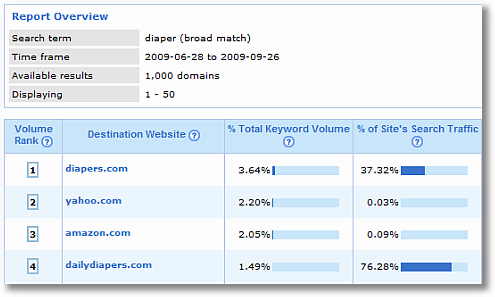
www.diapers.com has a 3.64% "share of search" prior to the campaign. What was it after?
Did they make a dent in the universe?
I am using Compete for the above report. When you use it you'll notice that Target is #10, Babycenter is at #15 (with a 0.77% share which seems looooow!). If you run branding campaigns for either company you now know how you'll measure success.
You can index your performance for your campaigns, and against your competitors.
If you use broad-match like I did above you get a "category" view of your performance. If you use the exact match report. . .
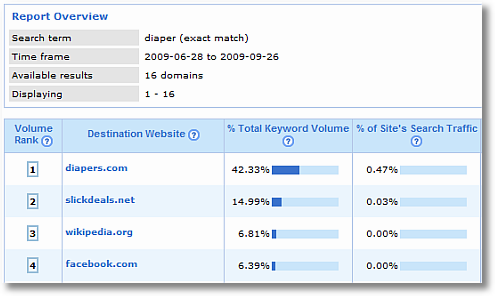
. . .to get a better idea about about "brand" performance (and find new competitors – facebook anyone? :)).
You can do this for pantene, shampoos, styling treatments, pro-v, 2-in-1 shampoo + conditioner… the world is your oyster.
This analysis also helps you understand how well your offline branding campaigns are doing online.
For example I don't know of airline companies that run more television campaigns than Southwest Airlines.
Yet currently for queries like cheap tickets, cheap airline tickets, cheap flights etc www.southwest.com does not show up in the top 15 in "share of search" reports, in some cases not even in the top 25. And that has not changed in the last few months (even with the barrage of new TV ads).
The TV ads are perhaps super productive in driving people to the phone or perhaps directly to the site, both desirable outcomes. But they are certainly not working in getting people who are looking for airline deals and searching for them to go to Southwest.com.
Traffic Differentials
If your campaigns are successful you'll know it from your Site Analytics tools like Google Analytics or Yahoo! Web Analytics. But in the grand scheme of things did you have an impact?
Use tools like Google Trends for Websites (or Compete or HitWise) to analyze your performance…

In the report above if you (Hilton Hotels) ran your campaigns in March 2008 (purple arrow) then you managed to accomplish nothing. Notice the competitive trends?
If you ran your magnificent branding campaigns in Jan 2009 then buy yourself some beer and dance around because you can see, against competition, you clearly narrowed the gap (black arrow).
Of course you would not stop at the simple analysis above, that's just a start. You can export data into excel, you can segment it by Geo and ensure the lift is where your campaigns were targeted, you can segment by demographic and psychographic visitor attributes to see if you got the right kind of people.
Using Share of Search or Traffic Differentials are just two of many ways in which you can measure if your branding campaigns are indeed crushing your competition. There are many other analyses you can do, there are many other tools you can use. Don't give up, look.
Outcome #7: To emboss your brand into someone's skull.
As Marketers we try and do this all the time as well.
You say Jeans, and people say Levis.
You say Jonas Brothers, and people say Pink by Victoria Secret (I kid you not, yes I was surprised, I have research to back this up!).
You say online search, and people say Bing! No, not so fast! Google!! Ok maybe it's just a matter of time. :)
You catch my drift.
Branding campaigns are particularly effective at "embossing" brands into your psyche with the goal of improving unaided brand recall.
The challenge of course is how do you measure this elusive, but very desirable, outcome.
I have two suggestions.
Primary Market Research
In the online world we don't make enough use of primary market research, and that's a shame.
Field surveys, focus groups, interviews etc can be used very effectively to gain a indepth understanding of your customers and their influences (hopefully channels and methods you use to influence them show up in the answers!).
There is a ton of math and rigor involved in these studies that helps you get a great understanding of your audiences, even with small enough sample sets.
Plug into the Database of Intentions
I love that term: "database of intentions".
For now atleast search is used by many people as they seek information online, and that allows for this data to reflect intent, rising and falling trends, preferences etc.
You can use Insights for Search for this type of analysis.
I am a Assistant Senior Vice President of Brand Marketing Campaigns at Orbitz. I have been spending my lovely marketing dollars on tons of TV campaigns (See: Orbitz Golfers). Oh and a smidgen on online campaigns as well.
So what was the impact, when people search for "hotels" do they think of Orbitz? Here's the data you are looking for…

In the online database of intentions Orbitz is not on the horizon.
The data on the left is important because it tells you what people search for when they look for hotels.
The data on the right is killer. It shows which terms (hence brands, sites, properties) have risen the by the most statistically significant amounts. This is fantastic because it mines the data that is below the surface and brings the movers and shakers forward.
Some of Orbitz's competitors show up there, their marketing dollars seems to be working well in improving the likelihood that when people are doing category searches, hotels here, that they would look for expedia, priceline, hotwire, etc etc.
But I am not going to give up, I just started running these massive tv campaigns a few months back. Let's see the data for that!
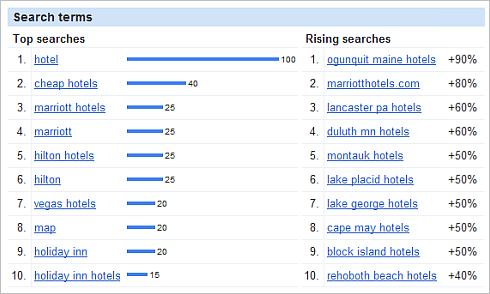
Hmm…. the "winner" here seems to be Marriott from the hotels category in the last 90 days. Good for them, sad for me.
Let me hasten to add that it is quite possible that the desired result of these offline (and online) branding campaigns was to get people to go to the site directly or call Orbitz on the phone.
The first premise you can measure easily, how is our website traffic doing when we are running all these campaigns…
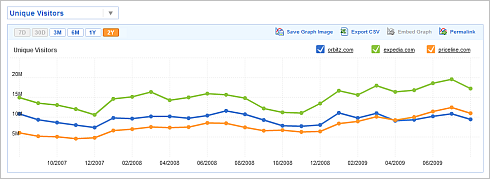
Two years of data. Expedia is green, Orbitz is blue, Priceline is orange (query on compete). It does not look too good for me (and if that was not enough Priceline just crossed me for the first time in my history, boo! boo!).
[It is important to point out I am simply doing outside-in analysis, a sport always fraught with risk. You on the other hand work at Orbitz and will have the tribal knowledge to make sense of this data better.]
For the last piece of analysis to measure unaided brand recall analysis, I'll try is to correlate my brand marketing spend with the number of phone calls to 1-888-656-4546 (and keep my fingers crossed that I'll see a massive spike in phone calls from the campaigns because, on the surface, it is hard to detect a impact directly on the site).
You can do this type of analysis for anything.
Let's say Victoria's Secret has indeed been heavily spending on branding campaigns for Pink by Victoria's Secret in the last 90 days. I can look at this data to see if the brand Pink is amongst the fastest rising by those people who look for Victoria's Secret "stuff"…

Not so much. Why?
Now if I were the Brand Manager for the Jessica White line then I would rejoice! While Jessica White is not in the "top related searches" category yet, it is rising very very fast as a result of my campaigns! Yes!
(Mental note to check later: What the heck is "victoria secret application"? Sounds dicey!! :)).
So there you go. A portfolio of seven strategies that you can use in the ultimate quest for any online marketer / analyst: measuring branding campaigns.
I hope they spark your creativity and lead you to finding even more innovative solutions to your unique challenges.
Buena Suerte!
Ok your turn now.
Are there other outcomes you can think of for your branding campaigns? Can you think of other ways to measure the seven outcomes mentioned above? If you have tried one of the above strategies did it work? If it did not, why not?
Please share your feedback / learnings / critique / kudos.
PS: Like this post? Perhaps you'll consider ordering my * new * book: Web Analytics 2.0.
PPS:
Couple other related posts you might find interesting:
- Excellent Analytics Tip #15: Measure Latent Conversions & Visitor Behavior
- Multichannel Analytics: Tracking Online Impact Of Offline Campaigns
- “Dear Avinash”: Be Awesome At Comparing KPI Trends Over Time
- Excellent Analytics Tip #12: Unsuspected Correlations Are Sweet!
- Standard Metrics Revisited: #5 : Conversion / ROI Attribution
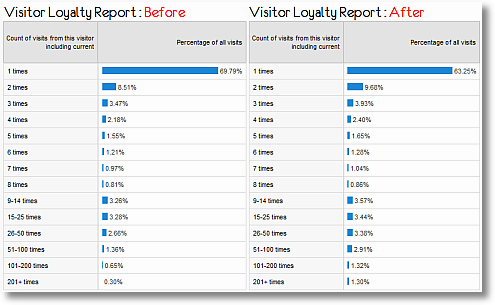





 Via
Via 
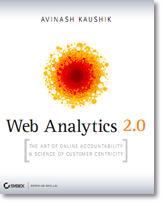













I chanced upon to view your blog and found it very interesting as well as very informative, i was need such type information, which you have submitted. I really thankful to you, this posting help a huge number of people.
Great … Keep it up!
I've been thinking a lot about brand measurement of late. Thanks for reading my mind and writing this post in such a timely fashion! :-)
One of my minor epiphanies of late is that brand measurement used to be a much more blunt instrument than it is today. In the "old days" of the late 90s and early 00s, companies were limited to a handful of tools: 1) brand financial results, 2) clip services, and 3) a semi-annual or annual (expensive) brand awareness survey. All of these were clunky at best.
In the digital world, we can measure brand performance (which is driven by offline campaigns, online campaigns, AND user-generated content) much more accurately, more inexpensively, and more frequently.
A key, and you touch on this, is that some of that measurement is outside of any WA tool: Google Trends is a great way to monitor how often people are thinking about your and your competitors' brands based on how often they search for the term, "online listening platforms" can be easily tweaked to monitor the volume of conversations about your (and your competitors) brand, as well as the sentiment associated with the brand.
I've been looking at brand measurement, at a macro level, as breaking down into four buckets: brand awareness, brand engagement (sorry), brand acquisition (database growth), and brand financial results. Thinking through which these areas a "brand" campaign is trying to impact is key.
Thanks for some excellent Tuesday morning food for thought!
Hi Avinash,
Excellent post. I think most of your posts now tend to be like manuals (contain everything needed).
My opinion about brand measurement is that some traditional agencies do not want to measure their campaigns with all these brilliant methods. They have some established methods and do not want to change. Why to make all this analysis and highlight all the weak points of their campaigns.
They prefer to have some soft metrics that could have many interpretations. I think web analysts can add value and be the independent voice to analyze the results of these campaigns. However some agencies are doing very good work in matching offline and online behavior.
Thanks again,
Christos
Yes, I absolutely agree this is almost written like a how-to manual.
Well done.
This is an awesome post.
I'd like to add one small thing for online branding (PPC) campaigns, and that is that you don't automatically HAVE to send all of your branding traffic to your site's homepage by default. I've seen this a couple of times online and I really like it, where marketers send traffic to a specific "branding landing page", which is basically a nice bulleted or numbered list of everything the company is about and what they do. Or your "About Us" page may be a nice alternative.
I say this because a lot of times site homepages are cluttered with flash, animations, well-written slogans and nice wide-screen HD digital photography that takes up 3/4 of the fold…none of which do a good job of introducing who you are and what you do :)
Hi Avinash,
Under Visitor Recency (Outcome #2) you compare All Visits with Paid Traffic. The Paid Traffic number is 27.97%. Does this mean 72.03% of the paid visitors visit more than once?
Rishi
Hi Avinash,
Nice article. Agreed that analytics is "a key to measure". Also agreed to the point that anything that is online, can be measured, One of the online school principles is "measurement". we can measure it till the depth of goals, provided its online.
The real pressure is measuring offline sales. It totally lies with the transparency of the client. Its difficult getting the sales from clients, Specially those who don't want to be a case study :). I hope someday we will be able to measure that too.
Truly an excellent post… Thank you for taking the time to post such an insightful and useful analysis.
To attempt an answer to your parting question and further expound on Joe Teixeira's point above…
Brand/Buzz monitoring is another valid measurement of a branding campaign. There are many tools available to monitor what impact your campaign may have on the blogosphere, Twitter, forums, opinion sites,social networking sites, etc… These are useful tools to understand brand sentiment amongst key influencers and core audience. For example, a well known LCD brand locally here in Thailand had a massive PR and brand problem where they were getting flamed in the forums and the colloquial reference to them became "Unlucky ". Through Brand Monitoring, we were able to see the impact and subsequent improvements as a result of the branding and PR campaigns aimed at changing the sentiment.
Additionally, to expound on Joe's post, the results don't always end up on the corporate website or even a microsite. It is perfectly reasonable, relevant and important for brands to "fish where the fish are" rather than always trying to lead them back to a website or microsite – thereby trying to lead them away from the pond. (TVC branding campaigns don't aim to get the viewer up off the sofa and into the store immediately, right?) Interaction rates, time spent, video views/starts/stops/replays, number of bookmarks, and other metrics are all valid ways to track branding impact along the way.
To summarize, there are metrics that can be tracked to better understand the impact of a branding campaign outside of one's website analytics, surveys, search trends, and traditional "Primary Market Research".
I think fundamentally, we as an industry need to find a way to make it simpler and easier for brands/products to measure the results of their campaigns. We have many tools, but we haven't made them easy to consolidate and analyze for broad consumption by marketers.
Thanks again for the excellent post.
Avinash, great post as always. The other day I read an interesting post on the differences between catalog & online marketers that described how online marketers are not as concerned with the lifetime value of a customer, brand awareness, loyalty, etc.. they are more concerned with getting people to convert NOW. I began to think of the relevancy of this post in the context of web personalization. It is clear to me that many online marketers are not embracing personalization technology because:
A) It is difficult to measure (you eloquently address this issue in this post)
B) Without a measurement vehicle, how can they justify the spend on personalization and other 'soft' marketing techniques that increase brand awareness, loyalty and the life time value if there is no immediate impact to the 'now'.
I have just submitted a blog I'm planning on posting on this very topic in the next day or so (yes, you beat me to it), but I will link back to your post here as it will hopefully add the measuring insight to how marketers can get beyond the 'now' and think of the 'lifetime' value of customers.
Regards,
Dan Piche
Great work Avinash!! I felt a rush of vindication reading this posting. Our company offers marketing measurement / ad tracking as a service to small business owners (and some larger companies).
At times, we catch some serious flack from advertising "traditionalists" because we preach that all advertising should deliver measurable outcomes – and of course the client should hire us to track them!!
While I believe in the (often intangible) value of branding and I recognize its impact it has on me as a consumer, as a business owner, I find it laughable that anyone would spend money on advertising without having tangible, quantifiable goals.
Branding should be a cherry on top – what you get from an ad campaign when you don't get what you really wanted!!
You can't win the game if you don't know the score. Keep up the great work. Love the blog.
Ben
In response to Ben Landers,
I absolutely agreed with your comments with the exception of "Branding should be a cherry on top – what you get from an ad campaign when you don't get what you really wanted!!"
I can understand the perspective. However, for many segments branding is key. It's the difference between Pepsi or Coke, Acer or Asus, Nivea or Vaseline, Gucci or Chanel, Sony or Samsung, Chevy or Ford, IBM or Accenture, Nokia or Motorola, etc..
But, to reiterate your point. Tangible and quantifiable (measurable) goals must be wrapped around the branding efforts to show as best as possible how each ad dollar is impacting the bottom line of the company. (Attribution)
tiwa
Tim: I think your five piece framework is a good one. It further sub divides the problem into five pieces and allows us to focus on each piece separately (and hopefully simplifies the impact). As you mention, it is all about the impact!
Christos: I agree that many agencies (and companies) don't want to do this hard work or look for places where they are performing badly. I firmly believe that while today they have a choice, that choice won't last very long. They are going to have to move, they are going to have to change.
Rishi: Yes, that is what the data is indicating. Another way to easily validate this in any tool is to simply export the raw numbers into excel and create your own percentages.
Dan: I agree that traditional marketers have some ways to go to evolve their mental models. In terms of personalization I think it is the curse of the web. We have so much we can do, but so little we can do efficiently. That of course will change with time, so we are looking at a bright future here (for those who get it!). :)
Everyone: Thanks much for the comments and the emails! Much appreciated.
-Avinash.
Brand measurement is always on the bottom of the list of things to do for many companies. And in my opinion many companies ignore the fact how important it is. They spend millions of dollars and not able to measure the online success. Thanks for your post. This will definitely help as a blue print for brand measurement.
I like Apple Ads
http://www.youtube.com/watch?v=VCL5UgxtoLs
Great post, as usual Avinash!
Strangely enough, I have posted a few days ago an post on the same topic. It's in french, so here is just the formula.
Branding campaign efficiency = (direct traffic + traffic from search engines that contains the name of my brand) ÷ website traffic.
I didn't make it through the entire post–will try to return to it–but you nailed it in the beginning. It's all about deconstructing goals. Measuring brand awareness *is* tangible. Identify the ways you are trying to create brand awareness then create metrics to measure outcomes. It's the basis of web analytics and it doesn't change because the purpose of your digital presence is "branding".
The term victoria secret application is most likely people looking for a job or an online job application. That company gets tons of applicants especially this time of year gearing up for holiday shopping.
Thanks Avinash for this great post!
Just a quick note though on outcome #4. The usual "approach" to measure lift is to compute the difference between the people who were more likely and the people who were less likely. In this case, turning a 54% site impact and a 44.
Thanks for this elaborate article!
I'm curious to know how the Goal 3 "engaged visits" is set. Are you creating a virtual page after a couple of pages are visited?
Béate: Each company will probably define it differently, please see this post:
“Engagement” Is Not A Metric, It’s An Excuse
That said, in this case I am defining it as people who spend more than three minutes on the blog (the minimum time required to grasp the minimum essence of any of my posts :)).
Hope this helps.
-Avinash.
Great post Avinash.
I have always been a huge fan of analysing rising and falling search terms as a sign of campaign effectiveness but also wider PR.
Any reason for the hotel examples? That is the industry my agency focusses on and, whilst your posts always have strong relevance to my work, it was thrilling to see you manipulating my clients data :)
Inspirational as always, thank you.
Hi Avinash,
That's an insightful post! But in the case of social media, if it's not just engagement what is the kind of numbers you can suggest to a client before the campaign starts. The client would probably be interested to know the % of returning visitors that he intends to get from the campaign before it begins. With social media isn't every campaign very very different from another. So there would be an issue of comparing to other campaigns. What do you think?
Hruthika: You are absolutely right. The campaigns will be different, my hypothesis is that the portfolio of desirable outcomes will be the same (perhaps amongst the seven that are covered in this blog post).
For example you are Greenpeace.
What you want out of any outbound online marketing effort will stay consistent: more donations, volunteers, people protesting in the street, selling "save the whales" stickers, leads, twitter followers, memberships etc etc.
What will change is your imagination in how we use the media channels. You might use Twitter differently from DoubleClick and that differently from AdWords and that differently from Facebook / email / …… With each you'll probably tweak your success metrics, but almost always ensure that there is a direct "line of sight" to your portfolio of desirable outcomes above. Else you are doing something wrong. :)
Rob: I gave a keynote at a major travel conference two weeks ago and had done a bunch of analysis, so travel was on my mind. :)
I am glad you found it to be of value.
-Avinash.
Avinash,
What a great post! As we move forward, seeing these case-by-case examples is exactly what we need to see in order to make that final leap in web analytics. I believe this leap is not only wanting to measure web results, but to think and breathe them. I really hope that your new book, Web Analytics 2.0, continues to deliver the same level of quality as is in your first book and your blog. I'm sure it'll deliver. Speak of the devil, your new book comes out this month!
(run, fellow readers… pre-order today!)
Hope all is well!
An absolutely great post, full of mega-useful advice. Well done Avinash!
I found the 4q-tool via your blog post and it seems to be great.
Now, this has nothing to do with the offline branding measurement that you talk about in this post but a great way to test if your *site* is making your brand stronger is to ask 50% of the visitors questions about the brand (such as likelyhood to recommend) *before* they interact with the web site and then ask the other 50% the same questions when they *leave* the web site. Then you could see what´s happening with the brand value during the visit.
Well, its quite casual for me to get into your blog,
your article is very interesting and helpful.
I'm a student from China,my major is enterprise competitive intelligence,and I'm quite interested in the area of marketing analysis.
I have got quite a lot of useful knowledge through your blog.
Thank you very much,I do believe your blog is of great benefit to others.
I admire your work O(∩_∩)O~
This post has me thinking about your earlier post on government web analytics. Several months ago, the CDC began a "re-branding" campaign for "Swine Flu" to "H1N1". The change was prompted by several factors including the fall of pork sales due to consumers assuming that you could catch H1N1 from eating pork.
If this were the primary reason for the re-branding campaign, the answer to the question of "Why %&#$!^ are you doing the 'branding campaign'?" might be to increase user understanding of the causes of h1n1. This is assuming that an increase in user knowledge would lead to higher pork sales.
I guess this would fall under Outcome #4 – to drive offline action? What do you think? How would you measure something like this where the outcome doesn't actually benefit you directly, but rather benefits someone else?
Mel: You are right, this would be #4 or 7.
The cdc, thanks to the pork lobby :), wanted the brand perception to change. Online I would use my "unaided brand recall" graph to judge impact of the cdc campaign:
http://www.google.com/insights/search/#q=swine%20flu%2Ch1n1&date=today%2012-m&cmpt=q
Looks like a neutral outcome?
Avinash.
Wow – Great post!
Best post I've seen on branding analytics.
Best,
Magnus
I am just trying to work out any increase in brand awareness following a website refresh…however I am in a very specific market and I can't get figures on any competitor as they are all too small. is there anything else I could look at or you could suggest to give me a rough idea?
Emma: I am not sure I understand your question completely, I am so sorry.
But let me take a stab…
If you simply refresh your website and do nothing else then it is unlikely that your "brand awareness" would have increased (how would people know that you had a old site before and now you have a new one?).
But if you refreshed your site and that was accompanied by an ad campaign touting your new site (or the badness of the old one! :)), then there might be an opportunity to use some of the techniques mentioned in the post to detect an increased awareness of your site.
Net, net, for awareness to increase there is something you would have to do, just updating the site might be one step but that by itself won't improve the chances that people know you exist.
All of the above assumes I kind of sort of understood your question right! :)
-Avinash.
PS: Typically with a website refresh you want to report metrics that show that the "efficiency" has improved. So if you had onexit surveys on your site then that your Task Completion Rate before and after the refresh (and that it went up!).
Or of course increase in conversion rate. Or reduction in bounce rates for key landing pages (if you focused on a refresh for those). Or reduction in cart abandonment (because you are doing such a good job of selling and convincing people). Or increase in up-sells and cross-sells. Or fewer pages from Entry to reach your key product pages (to show improvements in navigational elements). Or… more things like this.
In a nutshell what were the goals you were trying to hit with the website refresh and did the site become efficient/better at those?
Brilliant stuff Avinash, very insightful. I am reading your book :)
Great post, it sound more like a manual (well written and very applicable) on brand measurement, I like it.
I understand that traditional agencies are quite resistant to change, due to use of established methods, but if they inject new blood in their organization some will see a lot of since from this post. It's bound to revolutionize the way brand measurement is done.
Once again good work.
Hey!
Man it took me a while to read, well now im all done!
Interesting reading, and thx for that. :)
Brilliant information here!
I think Florian Heinemann, the former CMO of Rocket Internet, made a very good point at the "Online Marketing Rockstars Conference" in Hamburg:
"What else is branding, than delayed revenue"?
In the end we all want to influence purchasing decisions down the (time)line through branding campaigns. The challenge lies in to determine how much revenue is delayed by how much time…
I found that perspective really fresh and inspiring, as it aims to connect branding directly to the bottom line.
Nice . i'm to still researching about the growth of my site brand awareness .
sure it's take a long time . but, i think it's effective
Avinash, the click path link is currently broken, FYI. I'm going to keep reading though!
Gordon: Thanks for letting me know.
I've replaced it with Ifbyphone, they have a really great call tracking solution.
-Avinash.
Very useful blog and the areas of measurement are right on target with what I want. I see business as a war, destroy the competition, make them fearful, give mis-information, be mobile and have you be on their mind.
That said, how can I measure if someone says, : we saw your sign, or we see you all over. Unless they go to the internet, there are no tools.
I really like the concept of knowing what I want to brand first and to narrow that result. 2014 fast approaches and I will use your valuable blog as a foundation as I complete my $100K advertising budget.
BTW, let us know if you were able to gain some speaking engagements from the blog – that was your intention. And from what I read your brand is: an expert speaker on marketing.
With regard to #1, I'm not sure I agree with the premise; – "It is not very hard to measure these campaigns". I'm also not convinced the 'new vs returning' metric is particularly useful.
Most major sites have different ways of driving traffic. For example, daily newsletters and SEO. At the overall site level, the 'new vs returning' metric is generally much more reflective of the marketing mix, then of any particular campaign:
For example, in the scenario I describe, and improvement in SEO rankings would shift our mix toward more new visitors. Weakened rankings, higher return visit % as more of our audience are the registered daily newsletter folks.
Attempting to segment new vs returning by traffic source doesn't cut it either, as these just become proxy for performance of the source, and not a particularly good one.
The best measure I've been able to come up with for brand loyalty is simply "return visits to the site homepage". This is agnostic of how google ranks you, social and paid traffic drivers, etc, and gets to the point – how many folks are typing in your URL directly.
Curious to hear your thoughts –
Dave
Great job with getting this post on the first page of Google search results for "measuring brand online". Fortunately for us, the ranking is also correct as the article and it's comments are definitely worth a read.
Could you also write an article on "How to bridge the gap between the Mad Men and the Math Men?" or: how to convince the Brand Marketing Manager to commit to serious Online Metrics? In a lot of companies, success of campaigns is measured by reach & frequency (pageviews, downloads, PR mentions, etc.) over engagement (time on site, time in app, return visits, etc.), let alone activation (purchases, subscriptions, store visits, etc.).
Not because there is no web analyst that would understand how to measure this, but because there is fear the the results may be disappointing AND lack of understanding how to .influence metrics. through applying those skills used to create the campaign in the first place (creativity, intuition, humour, empathy). Bringing together the arts & sciences of marketing is something only a few campaigns do really well.
Even with all the possibilities of offline (real world) activation through online marketing that the mobile channel allows for, most mobile marketing start-ups find it hard to sell their solutions to the average CMO that is used to buying GRPs or OOH "Surfaces".
Have you found any strategies that convince most traditional media buyers / advertisers, or dare I say: creatives?
This was a brilliant article Avinash.
I read this one after your more recent post on LinkedIn which I also highly recommend: Brand Marketing: Metrics to Love.